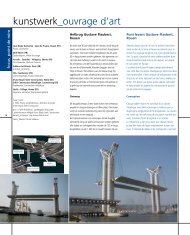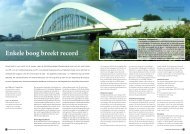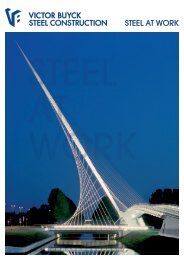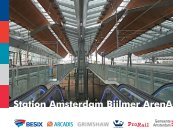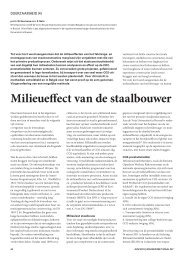environmental implications of steel bridge construction
environmental implications of steel bridge construction
environmental implications of steel bridge construction
You also want an ePaper? Increase the reach of your titles
YUMPU automatically turns print PDFs into web optimized ePapers that Google loves.
An important difference can be noticed between the <strong>environmental</strong> impact <strong>of</strong> the fully<br />
welded <strong>bridge</strong>s and the <strong>bridge</strong> that is partly bolted on site. If only the pure fabrication component<br />
is considered, the energy consumption is around 900 MJ/t for fully welded and 600 MJ/t<br />
for the partly bolted <strong>bridge</strong>. The global warming potential is roughly 140 kgCO2eq/t for the<br />
former and 90 kgCO2eq/t for the latter. If expressed in kgCO2eq/h, then these values become<br />
37.5 MJ/h and 5.8 kgCO2eq/h for the fully welded <strong>bridge</strong>s (with a very good correlation) and<br />
55 MJ/h and 8.5 kgCO2eq/h for the partly bolted <strong>bridge</strong>. These values take into account the<br />
rather important difference in complexity rate (expressed in fabrication hours per tonne).<br />
These values correspond very well with the fully welded components <strong>of</strong> the lock project.<br />
The values related to fabrication have to be increased with the overhead component, which<br />
is around 2,000 MJ/t and 110 kgCO2eq/t for the fully welded structures and 1,000 MJ/t and<br />
60 kgCO2eq/t for the partly bolted <strong>bridge</strong>, which is only half.<br />
As far as the erection component is concerned, it represents averagely 800 MJ/t and 63<br />
kgCO2eq/t for the fully welded <strong>bridge</strong>s (with a still relatively good correlation) and 700 MJ/t<br />
and 57 kgCO2eq/t for the partly bolted <strong>bridge</strong>. For the Kattendijk lock structures, with a minimum<br />
<strong>of</strong> erection because these structures were brought to the site fully completed (and could<br />
therefore be installed straight away), this component is considerably less: 200 MJ/t and 16<br />
kgCO2eq/t only.<br />
Due to the big differences in complexity and systems, it is not realistic to deduce systematic<br />
values for the corrosion protection component.<br />
If the transport component is considered, the values for the Nantes project are striking. The<br />
importance <strong>of</strong> the distance between the fabrication workshop and the <strong>construction</strong> is immediately<br />
revealed. From the research results, some typical values can be derived. Transport with<br />
inland navigation causes typically around 10 gCO2eq/km,t, trailer transport around 40<br />
gCO2eq/km,t. These values are only around half <strong>of</strong> those mentioned in the CO2 performance<br />
ladder emission tables. The sea transport for the Nantes project caused 85 gCO2eq/km,t (going<br />
journey). This value corresponds rather well with the mentioned published emission tables.<br />
If the return journey with empty barge is also taken into account (causing 60<br />
gCO2eq/km,t), then the total transport emission is 145 gCO2/km,t.<br />
If the overall <strong>environmental</strong> impact values are divided by the total number <strong>of</strong> hours (fabrication<br />
and erection), it seems that for the three fully welded <strong>bridge</strong>s the impact is very similar:<br />
around 130 MJ/h and around 14 kgCO2eq/h, excluding the transport component. For the partly<br />
bolted <strong>bridge</strong> project (which has considerably less hours per tonne), the values are only<br />
marginally higher: 170 MJ/h and 16.5 kgCO2eq/h.<br />
If the corrosion protection and transport components are not taken into account (because<br />
they depend on parameters that are predominately not related to fabrication and erection complexity),<br />
then it can be concluded that the impact values for the fully welded <strong>bridge</strong>s are 3,500<br />
MJ/t and 300 kgC02eq/t; for the partly bolted <strong>bridge</strong> this is 2,300 MJ/t and 200 kgCO2eq/t.<br />
For the lock structures these values are 3,700 MJ/t and 340 kgCO2eq/t.



